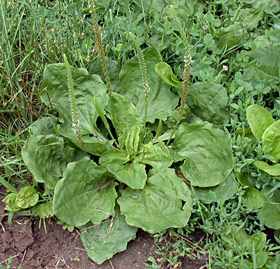Broadleaf Plantain (Greater Plantain), Plantago major

Photo from UMass Amherst Landscape, Nursery, and Urban Forestry Program.
IPM Steps to Reduce Broadleaf Plantains
1. Sample for Pest
Confirm the presence of broadleaf plantains before you treat.
Where to find it while inspecting: This cool-season perennial is found in lawns and bare soil throughout the growing season; prefers sun over shade, and some dampness.
2. Proper ID
Is it a broadleaf plantain?
Size and Appearance: A low growing broad-leaved clump (rosette). 3–8" long leaves are wide, oval, dark green, wavy, and generally smooth. The single flower stem can grow 8–20" from the center, flowers are greenish, tiny, dense, and tight to the seedhead stem—creating a “spike” appearance.
3. Learn the Pest Biology
What is the life cycle of broadleaf plantains?
Life Cycle: Reproduces by seeds which are produced in late summer. Seedlings emerge in late spring and summer.
Preferred Habitat: Any lawn area or weedy soil where larger weeds do not shade it out.
4. Determine Threshold
How many are too many?
Threshold: Athletic fields aim to keep broadleaf plantain density very low to avoid sports injuries caused by poor footing. Total broadleaf weed cover on playing surface should be less than 15–20%. In lawns, where weed cover is primarily an aesthetic issue, up to 50% broadleaf weed cover may be acceptable.
5. Choose Tactics
Creating a healthy soil condition and understanding turfgrass’s needs is the first step in reducing turf pests.
Best Management Practices: Removal of plantain before fall seed dispersal is your best chance to slow spread but you must remove the tap root. Give your turfgrass an edge in the competition: Maintain proper soil pH: 6.0 to 6.8 (test every 3–5 years). Fertilize according to soil test results and at the proper time during the growing season (see Fertilizing) for turfgrass root development, irrigate if needed, mow at proper height (removing no more than 1/3 of the blade), amend poor soil, choose proper turfgrass seed for your conditions, buy quality seed, overseed thin spots in fall or early spring, remove thatch. Most importantly, aerate to relieve compaction and overseed on a regular basis.
Treatment Methods: Nonchemical Control: Dig out individual plants before seed heads form (a weed popper tool will facilitate this). Use a thermal weed treatment device to kill individual plants (Note: apply heat to weeds only to avoid injury to grass). Chemical treatment: Broadleaf plantain can be chemically controlled with several products including two- and three-way combinations of broadleaf herbicides. The best control can be achieved when broadleaf plantain is actively growing, especially during spring and fall. The turfgrass area should not be mowed for two or three days before and after herbicide application. The treatment application should be done at a time when there is no rainfall expected for at least 12 hours. Check state and local regulations concerning pesticide use requirements. Select products carefully—research and consider product effectiveness and risks to human health and the environment.
6. Evaluate
Was the tactic successful? Record the date pests were first noted, and the tactic you used, and its success. Use one of our RECORD KEEPING tools.
For More Information:
Utah State University Extension Weed Guides: Broadleaf Plantain
UMass Amherst: Agriculture and Landscape Program: Broadleaf Plantain in Lawns
Remember:
When a pesticide application is necessary, all necessary and required precautions are taken to minimize risk to people and the environment and to minimize risk of pesticide resistance or pest resurgence. Pesticide use in your school may be prohibited or regulated by local policies or state and federal regulations. Risk reduction methods can include, but are not limited to, spot-treatment, the use of gel or paste bait formulations placed in inaccessible locations, injection into a crack or crevice, and other methods that reduce potential exposure.